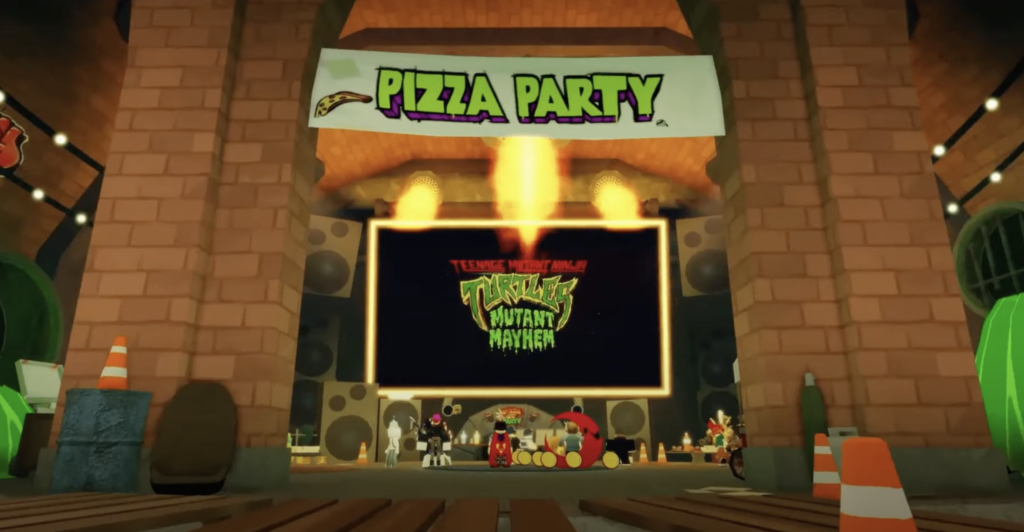There is no advertising without a media channel connecting messages to a target audience.
That’s why advertisers define ads based on their channel of choice, such as TV, print, digital, etc.
When it comes to gaming marketing, that dynamic differs. Since, when they’re not immersed in gameplay, audiences also experience gaming behaviors on a multitude of channels.
To explain, let’s explore advertising examples across the three gaming media categories.
In-game media
Video games are not media like movies or books, for example.
However, it is possible to integrate advertising into game environments.
That’s because video games are multimedia systems that can also act as channels.
Where in-game ads can take shape as anything from video to text to images.

For example, ahead of its August 2023 release of Teenage Mutant Ninja Turtles: Mutant Mayhem. Paramount Pictures launched an immersive movie trailer on Roblox.
Portal advertisements in other Roblox experiences promoted the trailer. They were designed to look like an in-game billboard displaying the movie title and its release date.
Upon entering the portal, however, players were transported to TMNT’s branded experience. Where they could participate in the trailer viewing party or leave the way they entered.
According to GameFam, the ads recorded 1.4 million visitors with the average visitor viewing the trailer to completion. A metric that points to enabling discovery at scale.
Around game media
Media behaviors beyond a video game’s virtual world mark the around-game experience.
This category covers gaming’s massive footprint on digital channels. Audiences share their own gameplay and view others on platforms like Twitch, for instance.
Around-game media is also key to meeting gaming audiences where they spend their time.
Especially since the top 5 game titles on Twitch alone racked up over 4.9 billion hours of watch time in 2023 (according to SullyGnome).
That’s also why technology provider inStreamly recently introduced Voice Recognition Mechanism (VRM). The AI-powered technology reacts to what a streamer says. So, brands can fit their message into the livestreamed content.
For instance, snack brand Monte’s gaming campaign used VRM to drive contextual awareness.
So, when a streamer used selected keywords, the livestream displayed the Monte logo.
Yet, even without ad tech, brands can still be part of the around game experience.
Kellogg’s Frosted Flakes, a breakfast cereal brand, transformed 70-year-old brand mascot Tony the Tiger into a VTuber on Twitch. A VTuber is a computer-generated avatar used to stream on platforms like Twitch and YouTube.

Twitch’s Brand Partnership Studio collaborated on the August 2022 activation. It featured Tony the Tiger playing a popular battle royale game with gaming influencers on the mascot’s personal Twitch channel. The influencers included Brennon “GoldGlove” O’Neill, Chrissy Costanza and Jakeem “BigCheese” Johnson.
The debut stream garnered over 17,000 hours (about 2 years) watched. Viewers also sent over 10,000 chat messages during the stream (according to Stream Hatchet). A level of engagement that is impossible using interruptive ads.
Away from game media
Gaming events are gatherings or occasions involving certain gaming behaviors. They can range from small local gatherings to massive international conventions.
Yet, regardless of the gathering size, all are examples of away from game experiences.
These events are also a hotbed for out-of-home (OOH) media. A broad category which includes anything not on TV, online or print.
OOH media + gaming events = away from game media
To demonstrate, the Evolution Championship Series (Evo) is the largest competitive fighting game tournament in the world. So, gaming agency REV/XP brought fast casual restaurant brand Chipotle there as a presenting sponsor.

Chipotle’s activation strategy effectively employed away from game media, such as:
- A one-of-a-kind branded Street Fighter 6 mural
- Rewards like entrée cards for competing players
- A dedicated Community Lounge equipped with LED screens and giveaways
The activation was part of Chipotle’s gaming media strategy across its work within the fighting game community.
Where the restaurant brand also executed a Street Fighter 6 integration (in-game media). It also offered free food as Twitch viewer rewards (around game media).
A track record that inspired the Evo crowd to loudly cheer every time a Chipotle ad appeared on the big screen.
If you like this content, subscribe to our YouTube channel for more gaming marketing insights and trends!

